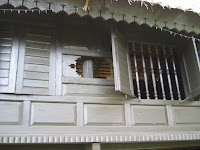The architecture of Istana Ampang Tinggi, Seremban
This is after all Visit Malaysia Year, right?
So, to divert some attention from the current hotspot in Ijok, I want to talk a bit more about good ol' Seremban.
Desi likens it to Peyton Place but he probably did not notice that Christmas has come a good 8 months early over here. If you are travelling from KL and exit into Seremban town via Jalan Sg. Ujong, you will not miss the very festive lightings dangling from the trees lining the streets all the way to the Terminal One bus-station.
That's how I feel these days as I drive along this road whenever the lights are on. Our MB sure knows how to generate some "feel-good" mood to match those propaganda churned out daily by our news editors.
Anyway, I digress.
If you frequently bypass Seremban whenever you travel along the North-South highway, perhaps I might interest you to drop by my little hometown and have a cuppa before you journey on.
The state museum is located just 100m from the toll booth and the few buildings that make up the whole place have some pretty interesting Minangkabau architectural details. One that fascinates me is the Istana Ampang Tinggi.
This particular building has an ageless charm and beauty which is hard to describe in words but hopefully the pictures I am sharing with you here will impress you just as much.

Part of the Istana Ampang Tinggi viewed from the left hand corner. There is a full-view picture in my earlier post titled "Postcards from Seremban".

The official sign greeting visitors next to the main entrance to the Istana.

A front view of the wooden panels on the left hand side of the building.

A beautiful row of delicately carved floral motives found beneath the windows to the left of the main staircase.

Another view of carved floral motives, this time to the right hand side of the main staircase.

Even the handrails on the staircase is an impressive display of fine craftsmanship.

This thatched roof was not part of the original building but perhaps a close replica.

The narrow left-hand side interior of Istana Ampang Tinggi, viewed from the entrance.
********************
A BACKGROUND HISTORY OF ISTANA AMPANG TINGGI, NEGERI SEMBILAN
The timber palace contains an unusual number of finely carbed panels and a pair of heavy sliding doors, which cannot now be found anywhere else in Peninsular Malaysia.
The palace was built by the fifth Yang Dipertuan Besar of Negeri Sembilan, named Yam Tuan Ulin', who ruled from 1861 to 1869, on a ridge overlooking a wide expanse of ricefields, and when it was completed the Yam Tuan gave it to his daughter, Tunku Chindai when she married Tengku Muda Chik, the son of the forth Yam Tuan, Yam Tuan Radin.
The palace stood about six miles from Sri Menanti. Tengku Muda Chik added some more carved panels and he and his wife lived there. The palace was later given to their daughter Tunku Halijah, who married Yam Tuan Muhammed, the seventh Yam Tuan, as his second wife. When Tunku Halijah died in 1921, it was occupied from time to time by other members of the family. But from about 1930 it ceased to be in regular use and fell in disrepair.
In 1953 the eighth Yam Tuan, Tunku Abdul Rahman, gave permission for the old building, which by then had no roof, to be dismantled and transported to Seremban. This could be done because no nail had been used when the palace was first constructed. The central portion of the building was re-erected on a site close to the State Secretariat and was converted into a Mini Museum containing weapons, and other historic artifacts made or used in Negeri Sembilan. The building has since been moved to a new site about three miles from the town centre of Seremban.
(Source: Information board displayed on the site of Istana Ampang Tinggi, Museum Negeri Sembilan.)






1 Comments:
Do you have a direction?
Post a Comment
<< Home